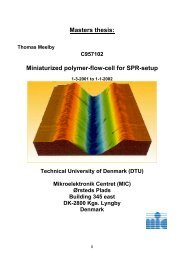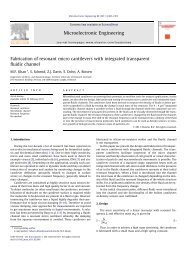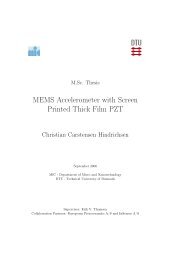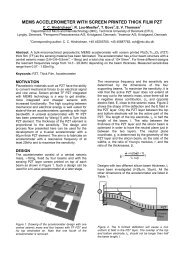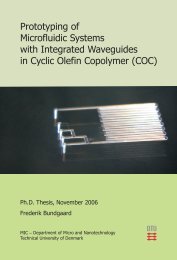C - DTU Nanotech - Danmarks Tekniske Universitet
C - DTU Nanotech - Danmarks Tekniske Universitet
C - DTU Nanotech - Danmarks Tekniske Universitet
Create successful ePaper yourself
Turn your PDF publications into a flip-book with our unique Google optimized e-Paper software.
A<br />
B<br />
5.1 Materials and Methods 29<br />
40 mm<br />
26 mm<br />
Vessel: with a laser machined bottom<br />
Vessel: created as hole<br />
Bores for screws<br />
Figure 5.2: WinMarkPro drawings of the freezing chambers: (A) shows the drawing from<br />
design I and II, where the bottom of the vessel was fabricated with the laser. In<br />
the drawing from design III and IV (B) the vessel was fabricated as a hole, since<br />
the vessel bottom consisted of aluminium or PMMA foil<br />
the CO2–laser models of the freezing chambers were drawn with WinMarkPro. The laser<br />
settings were shown in Tab. 5.1, whereas the settings were based on experience values, such<br />
as the laser velocity, and on the reiteration of the machining process. The dimension of the<br />
laser machined PMMA plates were 20x40x2 mm 3 . Additionally the plates had two bores for<br />
screws, 26 mm apart from each other, and the edges were also cut (Fig. 5.2).<br />
A PMMA plate with an area of 20x40 mm 2 and cut edges represented the standard shape<br />
for thermal bonding which was used throughout this thesis. This shape was used, because<br />
the steel blocks, needed for thermal bonding, had an alignment apparatus for this shape.<br />
Design I and II<br />
The vessel, only machined with the laser (laser settings and WinMarkPro drawing are shown<br />
in Tab. 5.1 and Fig. 5.2), had in design I a depth of 1.5 mm (resulting bottom thickness:<br />
0.5 mm) and in II of 1.75 mm (resulting bottom thickness: 0.25 mm). The depth of the<br />
Shape<br />
20 mm



